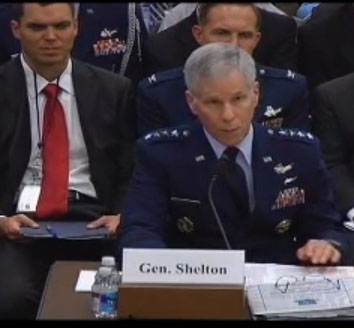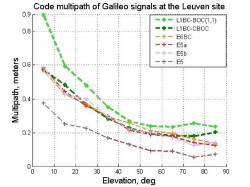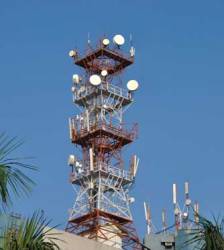 Air Force Space Commander Gen. William Shelton at House Armed Services subcommittee hearing
Air Force Space Commander Gen. William Shelton at House Armed Services subcommittee hearingTests of LightSquared’s proposed wireless broadband transmissions in the lower LightSquared band (1526–1536 MHz) caused harmful interference to a majority of personal/general navigation GPS receivers.
Tests of LightSquared’s proposed wireless broadband transmissions in the lower LightSquared band (1526–1536 MHz) caused harmful interference to a majority of personal/general navigation GPS receivers.
Today (December 14, 2011), a technical steering group of the National Space-Based Positioning, Navigation, and Timing (PNT) Executive Committee reviewed an evaluation of test results by the National PNT Systems Engineering Forum (NPEF). Additional tests had been ordered following a September 13 public notice by the Federal Communications Commission (FCC) after more extensive testing done last summer revealed widespread interference from LightSquared’s terrestrial transmitters at the higher band (1526-1559 MHz) adjacent to GPS L1, which LightSquared has petitioned the agency to allocate to it.
Although the new round of tests found no significant interference with GPS receivers integrated into cellular phones, other types of personal navigation devices were affected. Separate analysis by the Federal Aviation Administration also found interference with a flight safety system designed to warn pilots of approaching terrain, according to a press release issued by National Coordination Office for PNT (NCO).
Anthony Russo, NCO director, said the findings would be sent to the National Telecommunications and Information Administration (NTIA), which advises the President on telecommunications policy and represents federal agencies to the FCC.
“Over the next several weeks, the final analysis of the findings will be completed and a final report will be transmitted from NTIA to the FCC,” Russo stated.
Last week, a Bloomberg news report cited a draft summary of the results from the tests that 69 out of 92 receivers tested, or 75 percent, “experienced harmful interference” at the equivalent of 100 meters (109 yards) from a LightSquared base station.
LightSquared suffered another setback today when the U.S. House of Representatives passed a bill that prohibits the FCC from providing “final authorization for LightSquared operations until Defense Department concerns about GPS interference have been resolved.”
Rep. Mike Turner, an Ohio Republican who chairs the House Armed Services Subcommittee on Strategic Forces, proposed the language in the 2012 National Defense Authorization Act (NDAA).
The Commander of Air Force Space Command, Gen. William Shelton, stated at a hearing held by Turner’s Subcommittee in September 2011 that, “tests show LightSquared signal causes significant interference to military GPS.”
“Our military is heavily reliant on GPS capability to do its job,” Turner said of his proposal. “It is unacceptable for our armed forces to be put at greater risk or made less effective as a result of LightSquared’s operations. Congress and the Defense Department must have assurances from the FCC and this Administration that it will fully resolve the harmful interference issue prior to granting LightSquared final authorization to provide service.“
Meanwhile, on Monday (December 12, 2011), LightSquared proposed to make deployment of its terrestrial operations in the spectrum closest to GPS be subject not only to the consent of the FCC but also to the “explicit consent” of the National PNT Executive committee.
The company also offered to limit its power on the ground by eliminating the final phase of increasing power to –24 dBm and extending the period during which it maintains power at the lower level of –30 dBm to January 1, 2016, instead of a year earlier as originally planned.
The offer was conditioned on the company receiving “an FCC Order satisfactory to LightSquared that removes the condition relating to commercial launch of the company’s terrestrial network on its lower 10 MHz downlink channel (1526–1536 MHz) and its entire uplink band (1626.5–1645.511646.5–1660.5 MHz).
In response to this proposal, the Coalition to Save Our GPS called the move “a constructive step,” but added, “Unfortunately, LightSquared ties its agreement to do that to being given the green light to proceed full steam ahead in the lower 10 MHz, which is very premature,”
A second round of tests still lies ahead that would evaluate proposed mitigation plans for high-precision and timing receivers. The latter tests will not begin until LightSquared develops a filtering solution for such devices.
Last week, the company announced that testing conducted by an unidentified “independent laboratory” has confirmed that several major high-precision receivers, including those developed by Javad GNSS, “are 100 percent compatible with LightSquared’s network.”
LightSquared commissioned independent lab to test GPS interference solutions developed by three private companies — Javad GNSS, PCTEL and Partron. The company claimed that three additional “high-precision GPS manufacturers —all members of the Save Our GPS Coalition — have also developed solutions that have been tested at the lab. Initial testing by one of those companies, Hemisphere GPS, has gone very well.”





